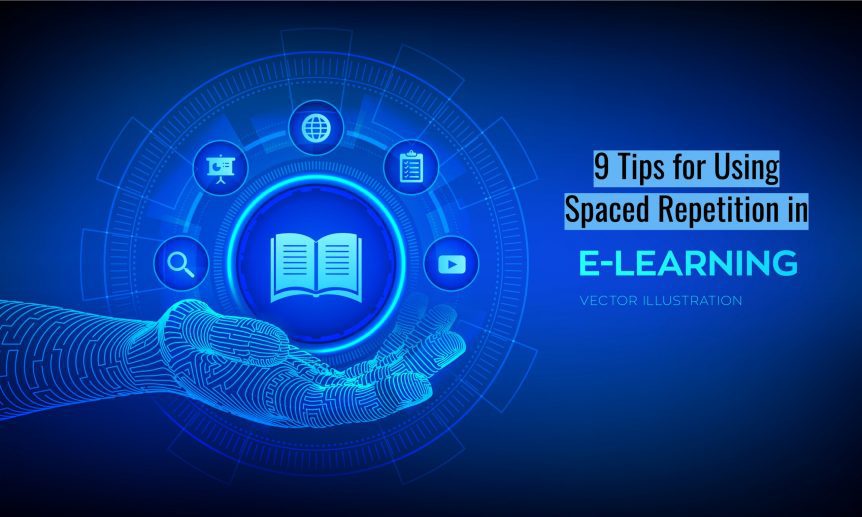9 Tips for Using Spaced Repetition in E-Learning
You will have several objectives when creating training courses in your business, including getting a return on investment. Another objective that will be high on your list is ensuring the people who complete the training retain the information they learn. Using e-learning as the delivery method can help with retention levels in a range of topic areas. Spaced repetition can help too.
Spaced repetition is a learning technique that has applications in several areas. This includes students maximising the effectiveness of their study techniques and to improve the teaching of school-age children.
Spaced repetition is also applicable to adult learners, including in business training situations in the UAE and Saudi Arabia.
In previous blog posts, we have looked at why spaced repetition is important and why it works. In this blog, we have tips that will help you implement spaced repetition in the e-learning courses created by your business.
Before we get into the tips, though, let’s do a quick recap on the concept of spaced repetition.
Brief Spaced Repetition Overview
Spaced repetition involves repeating recently learned information for learners to review. The intervals between each repetition are increased as the knowledge becomes embedded.
The idea is to teach or train your team according to the way our brains work.
One effective way to look at this concept is through the Forgetting Curve. It shows that we forget information we have learned as time passes with no need to recall the information.
Importantly, the curve is at its steepest early in the process. In other words, if we learn something but then have no need to recall the information again soon afterwards, we are more likely to forget it.
This is where spaced repetition comes it. The goal is to reinforce the information before it is forgotten and to continue doing this until it goes into the learner’s long-term memory.
9 E-Learning Spaced Repetition Tips
-
Experience Is Important
While spaced repetition can be a highly effective tool to use in your e-learning courses, it is an advanced training concept. Therefore, knowledge and experience of the method are important to ensure it is effective.
So, make sure the team developing your e-learning course understands spaced repetition and how it works.
-
Communicate with Learners
You don’t need to go into in-depth detail about spaced repetition with your team, but it can be helpful to introduce the concept, so learners know what to expect. This will help ensure they are more receptive to the various content elements that you present.
-
Keep it Tight
Presenting too much information at once will dilute the impact of the spaced repetition approach. So, keep the modules or sections in your e-learning course short.
When it comes to spaced repetition, the shorter and more focused you make the modules or sections in your e-learning courses, the better.
-
Incorporate breaks
Breaks are an important part of the spaced repetition process for learning. Breaks allow the brain to commit information to memory before that information is pushed out by new concepts or ideas.
You need to consider this when developing your e-learning course. The previous tip can help, as can combining spaced repetition with other learning techniques, such as microlearning.
Making sure your e-learning course works perfectly on mobile devices can also help, as can empowering learners to complete sections of the course at times that suit them. Both approaches facilitate learners dipping in and out, making the spaced repetition structure of the course more effective.
-
Mix it Up
The content in your course will start to look boring and – well – repetitive if you present it the same way every time. You will get a much better result if you mix it up.
So, repeat the information you present to learners in different ways, using different contexts, media, and approaches.
-
Use Interactive Elements
Interactive elements can help with the above point as an interactive element can be a new way of repeating information you have already covered. An example is a quiz or scenario.
Interactive elements also help with active recall. This is where we typically learn at a faster rate when we can put what we have been learning into practice.
-
Repeat, Repeat, Repeat
You will need to repeat important elements at least three times.
This is an especially important point to consider if there are several key elements that learners need to retain as part of completing the e-learning course. If this situation applies, the course will need to be carefully structured for the spaced repetition approach to work.
-
Test and Provide Feedback
Use quizzes with constructive and informative feedback. This will help with other aspects of creating and implementing e-learning courses, such as assessing performance. It also shows individual learners the areas where they are strong and, more importantly, where they still need to improve.
-
Create Refresher E-Learning Courses
Spaced repetition works within a single e-learning course, so the approach ends when the learner completes the course. Remember, though, that knowledge retention is the ultimate goal. So, it can be beneficial to create refresher courses that learners can complete in the months following the main e-learning course.
This is especially beneficial if the new knowledge or skill is only used periodically by the learner as they could forget important elements in the intervening periods of time.
Improving the Quality of Training in Your Business
Spaced repetition will not be the answer to all the training needs in your business. It won’t even be the answer to e-learning performance, as other factors are important too.
That said, spaced repetition is a powerful tool that can help significantly improve results. Get started today.

